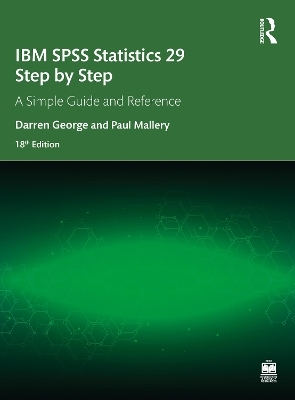
IBM SPSS Statistics 29 Step by Step
Routledge (Verlag)
978-1-032-62193-7 (ISBN)
Extensive use of four-color screen shots, clear writing, and step-by-step boxes guide readers through the program. Output for each procedure is explained and illustrated, and every output term is defined. Exercises at the end of each chapter support students by providing additional opportunities to practice using SPSS. This book covers the basics of statistical analysis and addresses more advanced topics such as multidimensional scaling, factor analysis, discriminant analysis, measures of internal consistency, MANOVA (between- and within-subjects), cluster analysis, Log-linear models, logistic regression, and a chapter describing residuals. New to this edition is a new chapter on meta-analysis that describes new SPSS procedures for analyzing effect sizes across studies, and the content has been thoroughly updated in line with the latest version of the SPSS software, SPSS 29. The end sections include a description of data files used in exercises, an exhaustive glossary, suggestions for further reading, and a comprehensive index.
Accompanied by updated online instructor’s materials and website data files, this is an essential resource for instructors and students needing a guide to using SPSS in their work, across the social sciences, behavioural sciences, education, and beyond.
Darren George teaches at the University of Alabama. His research focuses on intimate relationships and optimal performance. He teaches classes in research methodology, statistics, personality/social psychology, and sport and performance psychology. Paul Mallery is a Professor of Psychology at La Sierra University whose research focuses on the intersection of religion and prejudice. He teaches classes in research methodology, statistics, social psychology, and political psychology.
1. An Overview of IBM® SPSS® Statistics 2A. IBM SPSS Statistics Processes for PC 2B. IBM SPSS Statistics Processes for Mac 3. Creating and Editing a Data File 4. Managing Data 5. Graphs and Charts: Creating and Editing 6. Frequencies 7. Descriptive Statistics 8. Crosstabulation and χ2 Analyses 9. The Means Procedure 10. A Priori Power Analysis: What Sample Size Do I Need? 11. Bivariate Correlation 12. The t Test Procedure 13. The One-Way ANOVA Procedure 14. General Linear Model: Two-Way ANOVA 15. General Linear Model: Three-Way ANOVA 16. Simple Linear Regression 17. Multiple Regression Analysis 18. Nonparametric Procedures 19. Reliability Analysis 20. Multidimensional Scaling 21. Factor Analysis 22. Cluster Analysis 23. Discriminant Analysis 24. General Linear Models: MANOVA and MANCOVA 25. G.L.M.: Repeated-Measures MANOVA 26. Logistic Regression 27. Hierarchical Log-Linear Models 28. Nonhierarchical Log-Linear Models 29. Residuals: Analyzing Left-Over Variance 30. Meta-Analysis
| Erscheinungsdatum | 05.04.2024 |
|---|---|
| Zusatzinfo | 300 Halftones, black and white; 300 Illustrations, color |
| Verlagsort | London |
| Sprache | englisch |
| Maße | 210 x 280 mm |
| Gewicht | 1320 g |
| Themenwelt | Geisteswissenschaften ► Psychologie ► Allgemeine Psychologie |
| Mathematik / Informatik ► Mathematik ► Computerprogramme / Computeralgebra | |
| Mathematik / Informatik ► Mathematik ► Statistik | |
| ISBN-10 | 1-032-62193-1 / 1032621931 |
| ISBN-13 | 978-1-032-62193-7 / 9781032621937 |
| Zustand | Neuware |
| Informationen gemäß Produktsicherheitsverordnung (GPSR) | |
| Haben Sie eine Frage zum Produkt? |
aus dem Bereich


